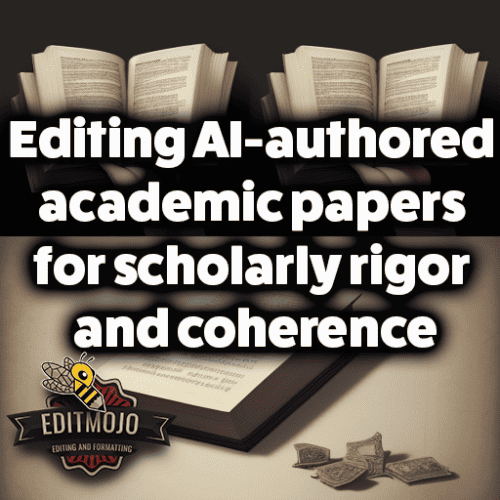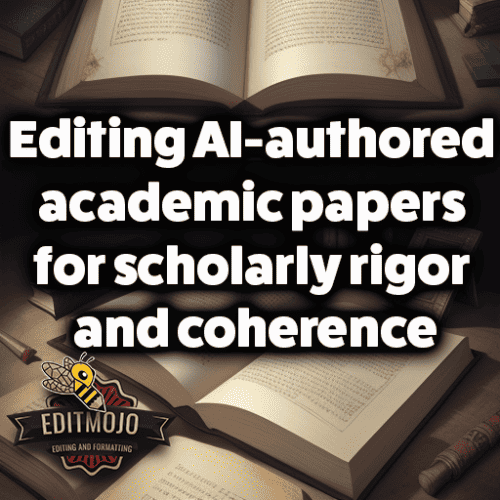Editing AI-authored academic papers for scholarly rigor and coherence
Editing AI-authored academic papers for scholarly rigor and coherence. In the realm of academia, the quill is being passed from humans to artificial intelligence. AI has journeyed from simplistic automation to generating complex, structured academic papers. The need and importance of editing these AI-authored academic papers for scholarly rigor and coherence cannot be overstated. This article dives into this fascinating juncture where technology meets academia.
Key Takeaways
| Key Point | Description |
|---|---|
| The Rise of AI in Academia | AI has evolved from generating simple reports to creating complex academic papers. |
| AI Strengths and Weaknesses | AI offers speed, efficiency, and the ability to process large data sets, but it often lacks depth and understanding of complex ideas. |
| The Role of Human Editors | Human editors can add missing context, ensure coherence of ideas, verify facts, and enhance scholarly rigor in AI-authored content. |
| Case Studies | Real-life examples demonstrate the crucial role of human intervention in refining and adding depth to AI-authored academic papers. |
| The Future of AI and Humans in Academia | The future is not about AI versus humans, but rather about a synergistic relationship that combines the strengths of both. |
Background and Context
Artificial Intelligence has, in recent years, slipped into the age-old tradition of academic writing. From humble beginnings in generating elementary reports to crafting comprehensive research papers, AI’s role has been transformative. But, it hasn’t been without its fair share of hiccups and hurdles.
Consider, for instance, the case of GPT-3, OpenAI’s powerful language model. While its ability to churn out academic prose at lightning speed is impressive, scholars note that its work often lacks depth, a keen understanding of the nuances of the topic, and sometimes even coherence. Clearly, while AI can handle the grunt work, human intervention is essential to ensure quality.

Understanding AI-authored Academic Papers
AI employs Machine Learning (ML) and Natural Language Processing (NLP) to write academic papers. Given a prompt or a set of data points, the AI analyses patterns, assimilates information, and produces written content. Think of it as a sophisticated parrot capable of mimicking the academic language, but not necessarily grasping the depth of the subject.
The strengths of AI-authored papers are evident. They offer unparalleled efficiency and speed, and their ability to process massive data sets is something humans simply can’t compete with. However, they often fall short in their understanding and representation of complex ideas and in capturing the subtleties and nuances of academic writing. This is where we humans come in.
Need for Editing AI-authored Academic Papers
Scholarly rigor and coherence are the backbone of academic writing. They help validate the credibility of the research and ensure the smooth flow of ideas. However, AI, at its current stage, struggles to fully embody these crucial aspects. Hence, the need for editing AI-authored content is not merely a luxury; it is a necessity.
Guidelines for Editing AI-authored Academic Papers
When editing AI-authored content, it is crucial to look for logical inconsistencies, disjointed ideas, and missing context.
Strategies for editing AI-authored content:
- Verifying and strengthening arguments: AI can sometimes make assertions that don’t hold up to scrutiny. For example, it might connect two unrelated studies to infer a conclusion, simply because the data points align. Always cross-verify facts and strengthen weak arguments.
- Ensuring coherence in ideas: AI doesn’t always understand the bigger picture. It might present ideas in a fragmented or disconnected manner. As editors, we need to weave these disparate threads into a coherent narrative.
- Adding missing context and nuances: An AI might fail to capture the subtleties of a topic, which could result in a rather dry, one-dimensional presentation. As humans, we can provide that missing context and make the content more relatable and comprehensive.
To maintain scholarly rigor, it’s essential to fact-check the AI’s work and ensure appropriate use of academic language and terminologies.

Case Studies
Let’s look at two real-life examples of editing AI-authored academic papers.
Case Study 1: Natural Sciences
The AI-authored paper was on the impacts of climate change on marine ecosystems. It was incredibly efficient in gathering and presenting data. However, it had made an incorrect correlation between two studies. The human editor caught this error, revised the argument, and added context about the varying impacts of climate change on different species.
Case Study 2: Humanities
This AI-authored paper tackled the influences of 19th-century Romanticism on modern pop culture. Although it accurately highlighted many historical facts, it had difficulty understanding and expressing the emotional and philosophical aspects of the topic. The editor stepped in, added depth to the narrative, and ensured the philosophical context wasn’t lost in the sea of facts.
Role of AI and Humans in the Future of Academic Writing
AI is poised to become an indispensable tool in academic writing. However, humans will still play an integral role in guiding and refining AI’s output. As I see it, the future isn’t a competition between humans and AI, but a synergistic partnership, blending the strengths of both.

Conclusion (Editing AI-authored academic papers for scholarly rigor and coherence)
Editing AI-authored academic papers is not just about fixing grammar and sentence structures. It’s about bridging the gap between the cold precision of AI and the nuanced understanding of human intellect. As we march towards a future where AI will become even more embedded in academia, let’s remember the importance of our role: to ensure the scholarly rigor and coherence of academic papers, be they penned by human or machine.
Top Five Questions and Answers
| Question | Answer |
|---|---|
| How does AI write academic papers? | AI uses Machine Learning and Natural Language Processing to analyze patterns, assimilate information, and produce written content based on given prompts or data points. |
| What are the strengths of AI-authored papers? | AI-authored papers benefit from speed, efficiency, and the ability to process large data sets. |
| What are the main issues with AI-authored papers? | AI-authored papers often lack depth, understanding of complex ideas, and may sometimes lack coherence and scholarly rigor. |
| Why do we need to edit AI-authored papers? | Editing AI-authored papers is necessary to ensure scholarly rigor, coherence of ideas, add missing context, and verify facts. |
| What is the future of AI and human interaction in academic writing? | The future is likely to be a synergy of AI and humans, with AI handling large-scale data processing and drafting, while humans refine, fact-check, and add depth to the content. |
Top Five Resources for Further Reading
| Resource | Description |
|---|---|
| Understanding AI and Machine Learning | A comprehensive introduction to AI and Machine Learning by IBM. |
| GPT-3 by OpenAI | Detailed information about GPT-3, OpenAI’s powerful language model used in AI-authored writing. |
| The Scholarly Kitchen | A professional blog by the Society for Scholarly Publishing. Offers insights on scholarly writing and publishing. |
| Artificial Intelligence in Academia | A scientific article discussing the role and impact of AI in academia. |
| Editing Tips for Effective Academic Writing | A guide by The Writing Center at UNC Chapel Hill offering practical tips for editing and proofreading academic papers. |
